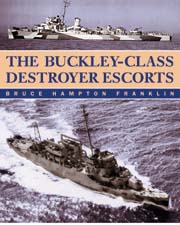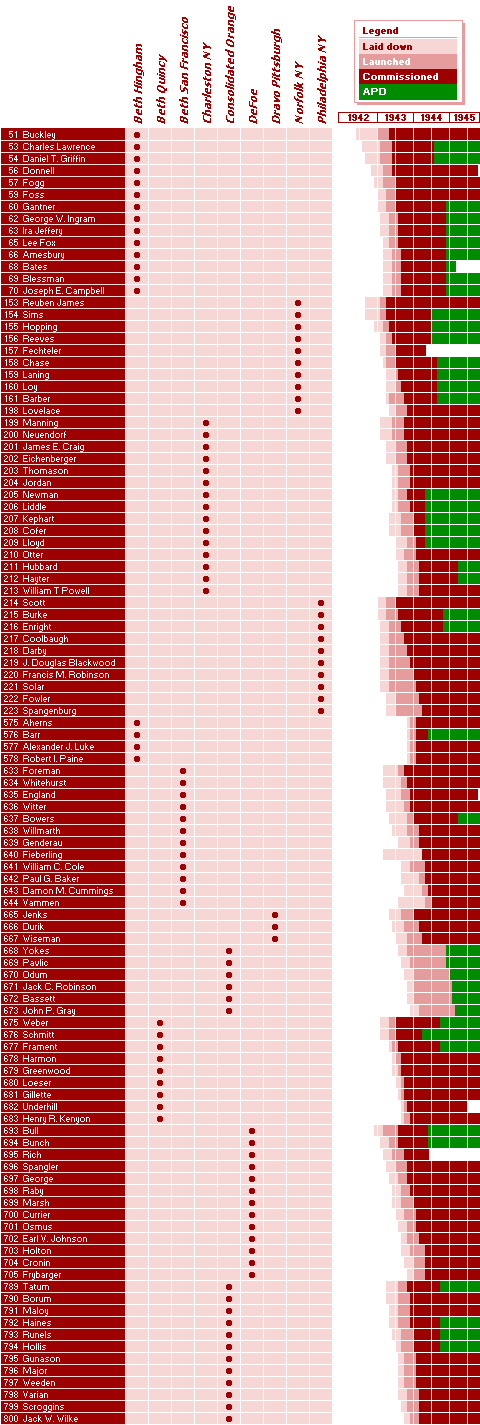
The Buckley-class Destroyer Escorts by Bruce Hampton Franklin
The Buckley class was a product of the January 1942 expansion of the DE program from 50 ships to 300 ships.
Availability of diesel engines was limited, however, by higher-priority submarine and landing craft construction. Accordingly, the Navy asked General Electric to develop a steam-powered turbo-electric design—the TE type—that would develop the 12,000 shp and 24 knots of the original DE concept.
The resulting design consumed more space than the original geared turbine plant, so the Evarts-class hull was lengthened by six feet to accommodate it. Thereafter, the Buckleys’ 306 ft. “long hull” became the standard hull for all follow-on DE classes. Bethlehem Shipbuilding at Quincy Massachusetts prepared the detailed plans.
After World War II, the TEs were favored over other DE types for continued service, in part because commanders in the Pacific war preferred their combination of power and an open bridge.
BUILDERS
Bethlehem-Hingham, Quincy and
San Francisco,
Consolidated, Defoe, Dravo-Pittsburgh, and the navy yards at
Charleston and
Norfolk.
GENERAL INFORMATION
Length: “Long hull” 306' 0" x 300' 0"
Molded Beam: 37' 0"
Displacement: 1,400 long tons standard; 1,740 full load.
Draft: Light: 9' 4"; Deep: 13' 6"
Designed Complement: Officers, 15; Enlisted, 198.
Shaft Horsepower: 12,000
Speed: Trial: 23.6 knots; Service: 23.5 knots.
Screws: Two.
Rudders: Two.
Bridge: High, open.
Stack: One.
ARMAMENT
Gun battery: 3 x 3-inch/50 caliber dual purpose guns.
Initial: 1 x twin 40mm Bofors.
Later: 3 x twin 40mm Bofors.
Short range: 9 x single 20mm Oerlikon.
Anti-submarine battery: 2 x depth charge tracks, 8 x depth charge projectors, 1 x Hedgehog.
MODIFICATIONS
During the war, plans were prepared to refit the entire class with two 5-inch/38 caliber guns. Eleven ships received this fit.
CONVERSIONS
In 1944, the Navy selected 50 TEs for conversion as
fast transports (APDs). Forty-three were converted: 37 after completion as DEs; the last six while under construction. Conversion of a 44th TE,
England, was suspended at the end of the war.
LOSSES
Six
Buckleys were lost during World War II or damaged and not repaired:
- Donnell was badly damaged by U-765, 3 May 1944, and not repaired, but used as a floating power station at Cherbourg, Normandy, France.
- Fechteler was sunk by U-967 off Oran, Algeria, 5 May 1944.
- Rich was mined off Quinéville, Normandy, France, following the D-day invasion, 8 June 1944.
- Bates (converted as APD 47) was damaged by suicide planes off Ie Shima and capsized and sank at Kerama Retto, 25 May 1945.
- Underhill was sunk by a Japanese midget suicide submarine, 25 July 1945.
- England was damaged by suicide planes off Okinawa and not repaired following the war.
DECORATIONS
Six
Buckleys were decorated for action during World War II:
- England received the Presidential Unit Citation for sinking six enemy submarines in twelve days, May 1944.
- Francis M. Robinson received the Presidential Unit Citation with Haverfield, Swenning, Willis, Janssen, and Wilhoite as part of a hunter-killer task group with escort carrier Bogue (CVE 9) in the Atlantic.
- Jenks received the Presidential Unit Citation with Pillsbury, Pope and Chatelain as part of a hunter-killer task group with escort carrier Guadalcanal (CVE 60).
- Buckley received the Navy Unit Commendation for her action in repelling boarders and sinking U-66 in May 1944.
- Underhill received the Navy Unit Commendation for action against enemy Japanese midget suicide submarines in which she was sunk, 25 July 1945.
- APD conversion Loy received the Navy Unit Commendation for anti-aircraft action off Okinawa, 1945.


